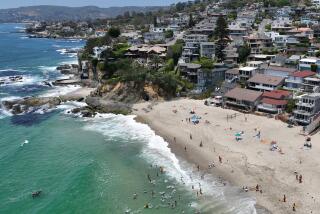America’s Hideaways Fall Prey to Popularity
- Share via
FRIDAY HARBOR, Wash. — Susan and Laszlo Pal strolled along the tranquil beach fronting their San Juan Island cabin and paused before the nearly completed two-story home next door.
“This used to be a small little bungalow, just like ours,” said Laszlo Pal, 65, who bought the 1,100-square-foot “Fish Cabin” with his wife 15 years ago.
“We’re feeling pretty humble next to these guys,” added Susan, 66.
The Pals were hardly surprised to see the 3,500-square-foot home spring up when the property changed hands. In recent years, construction crews have been swarming the San Juans, a chain of 175 islands some 85 miles north of Seattle. New condos and vacation homes renting for as much as $4,000 per week are filled with summer tourists, while even the shabbiest homes are now priced beyond the reach of most local workers.
The San Juans are not alone in their growing pains.
Dozens of such last, best places nationwide--think Nantucket, Key West, Aspen, Lake Placid--are being all but overwhelmed by their own appeal, said Jonathan Schechter of the Charture Institute in Jackson, Wyo., which studies growth issues.
The burning question now, Schechter said, is, “How do you do you deal with the growing popularity and not do irreversible harm to the very thing that made you attractive in the first place?”
So far, there are no easy answers.
The San Juans’ pull is immediately evident in the crush of ferry passengers at Anacortes, the mainland departure point. Vacationers and returning locals packed a ferry bound for San Juan Island on a recent weekend. They watched from the passenger deck as the bluffs and thickly forested slopes of a dozen islands slipped past.
“It’s a beautiful, beautiful place,” said Roger Salquist, 60, a recent retiree from Davis, Calif., who summers in a guest home he built on San Juan Island. His main island home is under construction.
San Juan County is one of about 50 tourist areas nationwide classified by the Charture Institute as PEAS: Places of Ecological or Aesthetic Significance.
Common pressures facing PEAS include rapid population growth and a spike in housing prices as the wealthy buy in. Rising prices put more pressure on wage workers.
“We have the largest affordability gap in the state” when average wages are compared to home prices, said Sandy Wood, director of the Lopez Community Land Trust. “We have a great deal of wealth in the hands of a very few.”
The median home price in the San Juans, where singer Jewel is remodeling a home and Microsoft co-founder Paul Allen owns a 385-acre estate, was $291,000 in 2000. That was 34% more than in 1990, and the priciest in Washington state.
The county’s population grew 40% in the 1990s, to 14,000, faster than all but one Washington county. That has strained local services and a limited water supply.
Schechter traces pressures on PEAS in part to new technologies that allow many professionals to telecommute.
“People are saying, ‘I deserve it all. Why should I only go to a place I really love for two weeks a year, when I can live in the San Juans, in Jackson Hole or the Florida Keys, work there and have it all?’”
Some longtime tourist destinations are nearing crisis stage. Many locals on Nantucket, beloved for its unsullied beaches and maritime heritage, are being priced off the island.
“The average selling price of a home peaked at about $1.6 million before this most recent recession. The year-round community cannot compete,” said John Pagini, director of the Nantucket Planning and Economic Development Commission.
On nearby Martha’s Vineyard, a favorite of former President Clinton, mansions have sprouted like suburban tract homes.
San Juan County ordered a study of Nantucket and Aspen to discover how it might avoid their crushing growth.
The researchers’ answer: Sorry.
“There is little that can be done to prevent the wealthy from taking over privately owned rural lands and converting farm and forest to estates and trophy homes,” the Aquatic Resources Conservation Group of Seattle wrote in its study. “The problems of finding housing for workers and the children of current residents who are not wealthy will become much worse.”
The locals who clerk, cook and carry out the trash in trendy Friday Harbor on San Juan Island know all about sacrifice.
“Some people work four jobs to pay rent. You just do it,” said Sharon Touher, 40, a bartender at Herb’s tavern rearing two teenage daughters.
“Apartments go for like $700 a month,” said Marc Wynn, 40, a cook at Downriggers restaurant. “If you’re a dishwasher, you’re not going to pay $700 a month and get by.”
The oldest local, 105-year-old Etta Egeland, can recall when San Juan Island was home only to hardy homesteaders such as her grandparents.
But she’s not for barring the gates.
“I never wanted to see so many people here that we look around town and it’s just filled up,” she said. “But I’m one of those people too. Everyone has a right to do what they want to do.”
Schechter sees the San Juans moving with other PEAS into a “post-tourist” economy, where most local income is from pensions, investments and professional services performed elsewhere. San Juan County tops PEAS with 60% of its income in those categories.
But although such a shift can ease tourism-related pressures, it does little to make housing affordable for wage earners.
“I’m concerned about it,” said recent retiree Salquist. “Hey, if you want good restaurants and you want local services, you have to have an affordable place for people to live.”
More to Read
Sign up for The Wild
We’ll help you find the best places to hike, bike and run, as well as the perfect silent spots for meditation and yoga.
You may occasionally receive promotional content from the Los Angeles Times.






